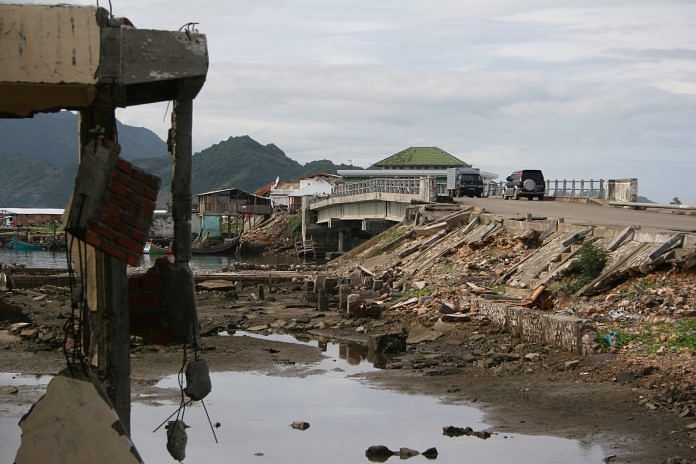The volcano was too close to land to give people enough time or warning to move to higher ground.
Bengaluru: A volcanic eruption in Indonesia set off a tsunami without warning Saturday, killing over 281 people, with over a 1,000 injured and at least 57 missing. Horrific videos on social media show the tsunami waves crashing onto people unexpectedly, including at a concert where band members were killed.
Saturday’s tsunami struck at about 21:30 local time (20:00 IST), during a local holiday. The proximity of the volcano to the coast prevented effective early warning and the full moon contributed to the strength of the waves, authorities report.
Mechanism of common tsunamis
Tsunamis are formed typically when the earth’s crust shakes itself up.
Imagine a bowl of water in your hand that is half full. As you walk with it and the bowl shakes, the water shakes too, producing small but discernible waves on the sides of the bowl where the water climbs and falls.
This is essentially what happens in tsunamis in the most common of cases — when they are triggered by earthquakes. Tectonic plates scrape against each other, slide under one another or rise up against one another during an earthquake. Sometimes, they move away from one another. This causes displacement of water, where a large quantity of water is suddenly moved.
On oceanic scales, this displacement causes a wall of water to often rise up where the earthquake occurred, just like shaking in a water bowl would. The wall then falls, the water and energy dissipated as waves.
In the large ocean, these waves stretch out horizontally and pass under the surface. This is why several fishermen out at sea during the infamous 2004 Indian Ocean tsunami didn’t feel it at all; tsunami waves cannot be felt in deep waters.
But as the waves approach shallow water, the tremendous energy they bring is stopped by the ocean floor and landmass. The rear of the wave is moving a little too fast to slow down as the front of the wave that hit the shallow waters. This causes another wall of water to build up, as the wave climbs on to itself, rising high above the water before crashing on to land and wreaking havoc.
Also read: Geography & coastal settlements make tsunamis more dangerous in Indonesia
A volcano this time
The weekend’s tsunami, however, was not caused by an earthquake. There had been no earthquake detected in the vicinity at all, although a volcano erupted at Anak Krakatau, half an hour before the tsunami struck with no warning.
Imagine climbing in and sliding swiftly into a bathtub that’s filled. As you enter from one end, the displaced water rises up as waves and spills out everywhere, as Archimedes discovered.
This is what happens in a volcano-induced tsunami, where a ton of volcanic material or other forms of soil spill into the water. The underlying mechanism is, once again, displacement. As rock, soil, sediment, and lava flow into the ocean from the volcano, water is displaced, causing waves to rise away from the volcano and move outward.
Anak Krakatau erupted half hour before the tsunami struck land.
Child of Krakatoa
Volcano-induced tsunamis are not unheard of. When Anak Krakatau’s parent volcano, Krakatoa, exploded in 1883, the four volcanic peaks that make up the island of Krakatoa blew themselves up, collapsing and depositing large amounts of earth into the water, causing tsunami waves over 45 m in height and killing 35,000 people as a result.
Anak Krakatau is a volcanic island that was formed after the famous 1883 eruption of the Krakatoa volcano. The 1883 eruption produced the world’s loudest sound, heard all the way across the globe. It travelled around the world four times, setting off sensors as it passed each time. The explosion obliterated the four volcanic peaks that existed in the Sunda Strait between Java and Sumatra.
The Anak Krakatau (“Child of Krakatoa”) was an underwater volcano that rose up above the ocean by constantly ejecting lava and building up in size as the lava cooled on itself. It became visible in 1927 and broke water in 1930. It produces lava flows much quicker than most other volcanoes, and far quicker than the waves can mellow them. It has been growing at a rate of 13 cm each year since the 1950s.
It has been constantly erupting since it formed, with several big eruptions in recent history. In 2017, one of its eruptions sent “lava bombs” into the ocean, almost hitting a nearby tour boat that had breached the 3km protective boundary around it. The incident was captured on video.
Tell-tale signs
Tsunami waves always come in groups, with successive waves hitting the shore, some more powerful than the others. Often, a tell-tale sign is the sudden receding of water into the ocean at the coasts.
During the Indian Ocean tsunami, the water receded from the coast for up to a kilometre at places in Tamil Nadu, purportedly revealing ancient carved boulders and architectural remains of temples, before the water came back and drowned everything in a wave of death. Receding water is almost always a sure fire way of detecting a tsunami, enabling lives to be saved.
This, however, doesn’t always happen. As in the case of Indonesia’s tsunami, the displacement immediately caused water to be pushed towards the land.
The proximity of the volcano to the coast also added to the complexity.
Since Indonesia sits close to the Ring of Fire, a tectonic boundary prone to earthquakes and volcanoes, it is prepared for earthquake-induced tsunamis. Authorities mentioned that tsunami-detecting buoys were placed into the ocean near the tectonic boundary. But the volcano was too close to land to set off the buoys or to give people enough time or warning to move to higher ground.
Also read: When comparing economies, pair India with Indonesia, not China






